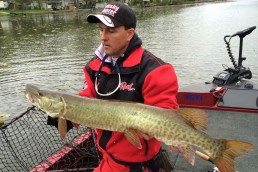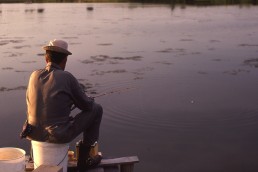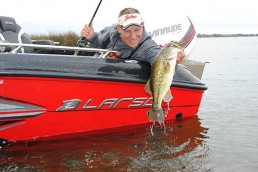Bank-beating Success
SHARE THIS POST
Years ago my friends and I used to snicker at the “bank beaters.” These were the anglers who we’d see seemingly mindlessly casting lures along the shoreline in search of whatever they could catch. Being taught about structure fishing and open water fishing at an early age, many of my friends and I often searched for large points, humps, channel edges and submerged roadbeds. Whether bass, walleye or muskie fishing, we almost always looked offshore first. Quite often we would find schools of big bass and walleyes in areas few others checked.
Fast-forward about 10 years. While fishing a southern reservoir, the muskies were tight to the bank. I checked other, offshore patterns, while my colleagues just cast at the bank and caught fish. Let’s just say I struggled. Actually, it was even worse than that. Despite joining the bank beaters and catching a couple muskies, I was stubbornly determined to continually look offshore for other muskie alternatives. The result was simple: I didn’t catch any muskies out there. Meanwhile, the bank beaters continued to catch lots of the targeted species. The evenings were full of fish catch stories, and I could not participate. That weekend still torments me a little. After that trip I vowed not to poke fun at bank beaters again, and, more importantly, never ignore the bank.
Bank huggers
In early season, one of the best places to find muskies is close to the bank. After all, this area is usually slightly warmer from solar heat, and it has the greatest likelihood of holding some type of shallow cover such as fallen trees or rocks. Also, riprap areas frequently warm from the afternoon sun in spring and attract baitfish. Plus, the crevices in the rocks offer hiding areas for smaller fish. Ultimately, the presence of shad in many southern and midwestern reservoirs dictates musky location in early spring, as do potential spawning locations. The bank and the shallow water associated with it can hold food, the warmest water and a spawning location. So, go beat the bank!
Not so fast. Many reservoirs have miles and miles of shoreline, which makes this approach nearly impossible. This is where you need to do a little homework to determine the best areas. Generally, the upper reaches of the reservoir with incoming creeks or the dam area and first adjacent creek arm are areas that hold muskies on most reservoirs. Don’t ignore the marina areas, either.
Three targets
Are you enjoying this post?
You can be among the first to get the latest info on where to go, what to use and how to use it!
Once you establish the better areas of the reservoir, now focus on three things: points, riprap and fallen trees along the bank. Points are natural migration areas for muskies moving between deep and shallow water. So, working the bank around points and the shoreline on either side of the point increases your odds of catching muskies.
The same holds true for riprap. Driving down the reservoir, look for areas of isolated riprap. These could be near the dam, a marina, a boat ramp, or there for some other random reason. Be sure to stop and fish some of those areas, as they can concentrate shad and muskies.
When it comes to fallen trees, it’s pretty tough to not cast to them, particularly when they are on or adjacent to a point. One thing to consider is that often when fallen trees start to break apart in the water from wind and ice, they can end up on the south side of the points. Those strong north winds associated with bad weather often have the power to move portions of the wood to the south side of the points. Just take a look at most reservoirs in low water conditions. Therefore, even though the south side of the bank along a point may not look like much, it could still have some unseen structure and hold muskies.
When fishing banks make sure you get your boat tighter to shore, make a few casts quartering or parallel to the bank and cast very tight to the bank. Some of my favorite presentations include shad-imitating minnow baits such as Shallow Invaders and Shallow Raiders; rattle baits such as JB Rattlers; and glider baits such as Phantom Softails. You can fish all of these lures close to the bank, around cover and you can fish them fast or slow. Experiment with retrieves while working along the banks and see how the fish respond. Once you see or catch one muskie, look for similar areas. One thing is certain, early season muskies can be patterned; it sometimes just takes the patience to beat the banks and get them to react. MWO
If you want to learn even more about muskie fishing be sure to check Musky Hunter magazine or muskyhunter.com. Also, watch “The Musky Hunter” television show—pure muskie fishing from the comfort of your own home at muskyhuntertv.com.
MWO
SHARE THIS POST
Did you enjoy this post?
You can be among the first to get the latest info on where to go, what to use and how to use it!
Jim Saric
Jim Saric is a Legendary Angler in the Freshwater Fishing Hall of Fame, the host and executive producer of The Musky Hunter television series, editor at large of Musky Hunter magazine, a seven-time muskie tournament winner, and a contributing writer for numerous other publications.



